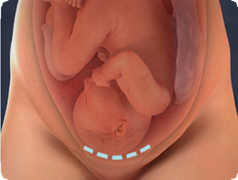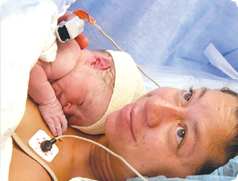Reasons for Cesareans
A cesarean birth is the surgical delivery of a baby through an incision in the mother’s belly and uterus. Cesarean births are done if a vaginal birth is impossible or unsafe for you or your baby.
Unplanned Cesareans
Unplanned cesareans are performed when they become necessary during labour.
Reasons for unplanned cesareans:
- Cephalopelvic disproportion (CPD), a rare condition in which the baby’s head does not fit through the pelvis (it is common for labour to slow down, and pushing efforts may be long and ineffective)
- Abnormal fetal heart rate
- Labour is not progressing despite augmentation efforts
- The baby moves into a position that makes vaginal birth difficult or impossible
 The cesarean incision is just above the pubic hair
The cesarean incision is just above the pubic hair
Emergency Cesareans
Emergency cesareans are rare and may be done at any point during labour. If an emergency situation occurs, general anesthesia may be given because it takes effect quickly. Using an existing epidural or rapid spinal block as pain relief during surgery is sometimes possible.
Reasons for emergency cesareans:
- A placental abruption, which is when the placenta separates from the uterus wall before the baby is born. This can cause severe bleeding.
- Cord prolapse, which is when the baby’s head is still high and the umbilical cord slips through the dilated cervix. The cord can get pinched by the baby’s head as it descends. A pinched cord blocks the flow of oxygen to the baby.
- Uterine rupture, which is a tear in the wall of the uterus that can cause dangerous bleeding for the mother and fetal distress.
- If your baby has a major drop or rise in his heart rate or has a flat heart rate that can’t be resolved by your healthcare providers.
 This mother holds her baby skin to skin as her surgery is being completed
This mother holds her baby skin to skin as her surgery is being completed
Reducing the Cesarean Risk
Studies indicate that some cesareans are avoidable.
How to lower your risk
- Avoid gaining more than the recommended amount of weight.
- Have continuous, hands-on support throughout labour. Be open to suggestions of different comfort strategies.
- Avoid inducing labour unless medically necessary.
- Stay at home during early labour
- Use upright or forward-leaning positions during labour and pushing.
- If you opt for an epidural, wait until labour is well established before getting it.
Download and Print
© 2017 InJoy Productions, Inc. All rights reserved.